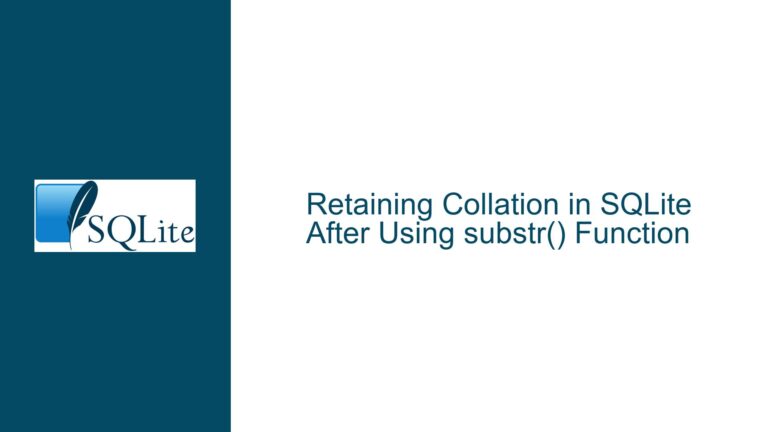Filling Nulls with Previous Non-Null Values in SQLite
Handling Null Propagation in Ordered Data Sets: Mechanisms and Constraints
Understanding Null Propagation Requirements in Sequential Data
The core challenge revolves around replacing NULL values in a column with the most recent non-null value from preceding rows. This is a common requirement in time-series data, sensor readings, or ring buffers where gaps (nulls) must be filled with the last valid observation. SQLite’s lack of native IGNORE NULLS support in window functions complicates this task, necessitating alternative strategies.
Key considerations include:
- Data Ordering: SQL tables are inherently unordered. Any solution must explicitly define row sequence (e.g., via
rowid, an explicit timestamp, or user-defined sort key). - Performance: Methods must scale efficiently, especially for large datasets or high-frequency inserts.
- Data Integrity: Solutions must handle edge cases like leading
NULLs, consecutiveNULLchains, and concurrent modifications.
Limitations of Native SQLite Functions and Row Order Assumptions
Cause 1: Absence of IGNORE NULLS in Window Functions
SQLite’s window functions (last_value(), first_value()) do not support the IGNORE NULLS modifier. This forces developers to emulate null propagation through subqueries, joins, or recursive CTEs.
Cause 2: Reliance on Implicit Row Ordering
Many solutions depend on rowid to infer insertion order. While valid in single-threaded, append-only scenarios, this becomes unreliable if:
- Rows are deleted, causing
rowidgaps. VACUUMis executed, which may reuserowidvalues.- Concurrent writes occur, as SQLite serializes writes but doesn’t guarantee insertion order across threads.
Cause 3: Trigger-Based Overheads and Race Conditions
Using triggers to auto-fill NULLs during insertion introduces:
- Performance Penalties: Each insert triggers a subquery to fetch the prior non-null value.
- Concurrency Issues: If multiple threads insert rows, the "last" value might not correlate with the inserting thread’s expectations.
Strategies for Efficient Null Handling and Data Integrity
Solution 1: Correlated Subquery for On-Demand Null Filling
For read-time null replacement, use a correlated subquery to fetch the last non-null value preceding the current row:
SELECT
rowid,
a AS original_value,
(
SELECT t2.a
FROM t t2
WHERE t2.rowid <= t1.rowid
AND t2.a IS NOT NULL
ORDER BY t2.rowid DESC
LIMIT 1
) AS filled_value
FROM t t1
ORDER BY rowid;
Mechanics:
- For each row, the subquery scans all rows with
rowid <= current_row, filters outNULLs, and picks the highestrowidvalue. - Efficiency: O(n²) complexity. Suitable for small datasets or infrequent queries.
Optimization:
- Add an index on
(a, rowid)to speed up theWHERE t2.a IS NOT NULLfilter.
Solution 2: Recursive CTE for Batch Processing
For datasets requiring a one-time null fill (e.g., data migration), a recursive CTE propagates non-null values iteratively:
WITH RECURSIVE
sorted_data AS (
SELECT
rowid,
a,
ROW_NUMBER() OVER (ORDER BY rowid) AS seq
FROM t
),
cte AS (
SELECT
rowid,
a,
seq,
COALESCE(a, 0) AS filled_value -- Default for leading NULLs
FROM sorted_data
WHERE seq = 1
UNION ALL
SELECT
s.rowid,
s.a,
s.seq,
COALESCE(s.a, c.filled_value)
FROM sorted_data s
JOIN cte c ON s.seq = c.seq + 1
)
SELECT rowid, a, filled_value
FROM cte
ORDER BY rowid;
Mechanics:
sorted_dataassigns a sequential number to each row.- The CTE iterates row-by-row, carrying forward the last non-null value.
- Efficiency: O(n) complexity. Suitable for medium-sized datasets (up to ~1M rows).
Edge Cases:
- Leading
NULLs are replaced with a default (here,0). Adjust as needed.
Solution 3: Trigger-Based Insertion-Time Null Handling
For applications inserting rows sequentially (e.g., ring buffers), use an AFTER INSERT trigger to auto-fill NULLs:
CREATE TRIGGER fill_null_on_insert
AFTER INSERT ON t
WHEN NEW.a IS NULL
BEGIN
UPDATE t
SET a = (
SELECT a
FROM t
WHERE rowid < NEW.rowid
AND a IS NOT NULL
ORDER BY rowid DESC
LIMIT 1
)
WHERE rowid = NEW.rowid;
-- Optional: Enforce non-null constraint
SELECT RAISE(ABORT, 'Cannot resolve NULL from prior rows')
WHERE (SELECT a FROM t WHERE rowid = NEW.rowid) IS NULL;
END;
Mechanics:
- After inserting a row with
NULL, the trigger updates it using the last non-null value from prior rows. - The
RAISE(ABORT)ensures noNULLremains if no prior value exists.
Caveats:
- Rowid Stability: Requires that
rowidorder strictly matches insertion order. AvoidVACUUMand deletions. - Concurrency: Safe only in single-threaded environments. Concurrent inserts may lead to race conditions.
Solution 4: Hybrid Approach for Ring Buffers
For ring buffers (fixed-size tables overwriting oldest entries), combine triggers with careful rowid management:
- Disable Auto-Vacuum:
PRAGMA auto_vacuum = 0; -- Prevent rowid reuse - Prevent Manual Vacuum: Ensure application doesn’t invoke
VACUUM. - Trigger with Ring-Aware Logic:
CREATE TRIGGER ring_buffer_insert AFTER INSERT ON t WHEN NEW.a IS NULL BEGIN UPDATE t SET a = ( SELECT a FROM t WHERE rowid = (SELECT MAX(rowid) FROM t WHERE rowid < NEW.rowid) ) WHERE rowid = NEW.rowid; END;
Mechanics:
- Assumes rowids are sequential and gaps are minimal (e.g., overwriting oldest row via
DELETE + INSERT).
Optimization:
- Maintain a separate table or variable caching the last inserted value to avoid subqueries.
Comparative Analysis of Approaches
| Method | Use Case | Performance | Data Freshness | Complexity |
|---|---|---|---|---|
| Correlated Subquery | Ad-hoc queries on small datasets | Low | Real-time | Low |
| Recursive CTE | Batch processing | Medium | Static | Medium |
| Trigger-Based | High-frequency inserts | High | Real-time | High |
| Hybrid Ring Buffer | Fixed-size buffers | High | Real-time | High |
Best Practices and Pitfalls
- Indexing: For subquery/CTE methods, index on both the sort key (
rowid) and the nullable column:CREATE INDEX idx_t_rowid_a ON t(rowid, a); - Concurrency Control: Use write locks (
BEGIN EXCLUSIVE) in multi-threaded environments to prevent race conditions. - Default Values: Handle leading
NULLs by setting a default in COALESCE (e.g.,COALESCE(a, 0)). - Monitoring: Profile query plans using
EXPLAIN QUERY PLANto detect full table scans.
Final Recommendations
- For Static Datasets: Use recursive CTEs for simplicity and predictable performance.
- For Real-Time Inserts (Single-Threaded): Implement triggers with
rowid-based lookups. - For High-Concurrency Systems: Avoid triggers; instead, handle null propagation at the application layer using cached values.






